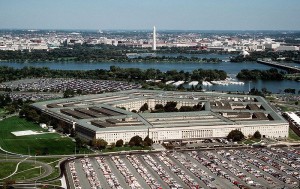The Need to Restructure the DoD: Part I
 In 1914, on the eve of the Great War, the Duke of Cambridge wrote, “There is a time for all things. There is even a time for change; and that is when it can no longer be avoided.”
In 1914, on the eve of the Great War, the Duke of Cambridge wrote, “There is a time for all things. There is even a time for change; and that is when it can no longer be avoided.”
Speaking of change, the current debt crisis could force drastic cuts in the Department of Defense budget, perhaps as high as 50 percent.
In the immediate post-Cold War era, DoD futurists envisioned a 25-year period of “strategic pause” before the nation faced a “major peer competitor” sometime between 2015 and 2020. In the 1990s, major candidates for peer-competitor status included China and a resurgent Russia. India and a nuclear-armed Iran were cast as lesser threats. In those heady days, terrorism was seen as a tactic and more the purview of law enforcement. The major emphasis was on being prepared for big wars against peer competitors—wars no world power can afford to lose. Preparing for those wars also satisfied each service’s need to perpetuate itself in familiar ways wrapped around developing and acquiring high-tech weapon systems. Programs like “The Army After Next,” “From the Sea,” and “Air Force Next” addressed future strategic paradigms focused on parochial core strengths.
To be sure, there were cuts in defense spending during the 1990s. The size of the American military shrank. The Air Force, alone among the services, reorganized its force structure from one based on strategic deterrence to power projection. Cuts were “salami slices” that, for the most part, reduced but did not reform outmoded force structures.
And then, September 11, 2001 changed everything. In the immediate aftermath, the Bush administration made a major mistake by declaring a “War on Terror” rather than specifying the enemy as Al Qaeda, associated groups, and nations that support them. With a generic “terror” as the enemy, the war easily morphed from one into two wars, with Operation Iraqi Freedom launched in March 2003. Ten years later, the fighting in Iraq continues, and what was originally a campaign to root out and destroy al Qaeda in Afghanistan has become an endless struggle against the Taliban. This war has exhausted the American military, contributed to our national economic nightmare, and derailed critical thinking about the future.
This exhausted force is also outmoded. Cutting such a force by a quarter, much less half, would invite aggression by nations like Iran and North Korea. Keeping the current force at the status quo would be expensive and also leave the nation vulnerable to current threats and unable to cope with a rapidly growing Chinese threat.
The U.S. military needs massive restructuring. Its current structure originated with the reforms instituted in 1903 after the Spanish-American War. A major overhaul on the eve of World War II made it possible to fight the Axis powers. The National Security Act of 1947 institutionalized the Industrial Age force extant today. Now, the armed forces of the United States would be hard-pressed to counter a North Korean invasion of South Korea without using nuclear weapons.
In fact, war on the Korean peninsula is one of our immediate threats. Iran, soon to be a nuclear-armed state, is bent on establishing hegemony in the world’s energy epicenter. Despite a predictably forthcoming declaration of “victory” in the ill-conceived War on Terror, al Qaeda and associated groups will continue to attack U.S. interests abroad while putting the nation on the defensive at home.
An anti-American alliance between Iran, Syria, North Korea, Venezuela, and possibly Cuba is not beyond the realm of possibility. If Mexico continues to descend into anarchy, that alliance could extend to our immediate and un-defended southern border; imagine the cost of trying to fortify it sufficiently to keep it secure.
Slicing the salami thicker will result in fewer divisions, cutting new weapons acquisition, and trimming at the edges by reducing costs associated with professional military education. This is like starting a weight reduction with a frontal lobotomy and removing a few fingers. What is needed is drastic restructuring of the armed forces, massive reduction in the associated bureaucracy, and major changes in the way officers are educated.
Meanwhile, China is building a first-class fighting force, one capable of global power projection. While Russia’s ability to project power remains questionable, its modernization programs focus on high-tech weaponry and on revitalizing nuclear forces.
Critics argue that the United States now spends more on its military than the next 10 nations combined. True. A lot of that goes to sustaining force structures that are redundant, unnecessary, and ill-suited for Information Age warfare. Much of it goes to personnel costs (including retirement), maintaining bases and posts that are no longer needed, and unnecessary civilian personnel. There is much that can be cut, but also much more that needs to be restructured if the United States is to survive the challenges beyond 2015.

